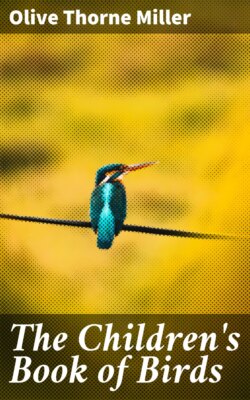Читать книгу The Children's Book of Birds - Olive Thorne Miller - Страница 27
На сайте Литреса книга снята с продажи.
XVII
ОглавлениеTable of Contents
HIS FAMILY AND FRIENDS
Many people think that as soon as the young birds of a nest are full grown, and know how to take care of themselves, the family separate, and have no more to do with each other. Some have even said that the old birds push the little ones out of the nest to get rid of them.
All this is a great mistake, and any one who has watched them carefully will say so.
In many cases, when the brood is grown and all have left the nest, the whole family keep together. One who has eyes sharp to see will find everywhere little groups of parents with their young. If the old birds rear more than one brood in a summer, the young ones of the first nest keep together.
I have often seen little parties of young bluebirds or sparrows going about after food on the grass, or on the newly cut hay. Now and then one of the parents would come around as if to see that all was well, and then leave them alone again. When the second brood is ready to go out, the whole family often unite in a small flock. In some cases, where they could be watched, they have been known to stay so all winter. All through July and August, in the New England and Middle States, one may see these pretty little family groups.
Some birds who live and nest by themselves, each pair in its own tree, or bush, or field, come together in larger parties after the young are grown, in a social way. A few do this only at night, in what are called roosts, which I spoke of in a former chapter.
Other birds, when nestlings are out, unite in flocks, and stay so all the time, or through the winter. Our pretty little goldfinch does this.
Most of the birds we see about our homes like to have a tree or bush to themselves for their nest. But there are many birds that live close together all the time. Some, you may say, in small villages,—swallows, for instance. We generally see several swallows flying about together. They make their nests near each other. The barn swallow chooses the beams inside the barn, and there are often three or four or more nests in the same barn.
The eave swallows put their mud cottages in a row, under the eaves outside the barn. One would think they needed to have numbers on their doors, to know which was their own.
There, too, are the common crow blackbirds. They come in the spring in crowds, and when it is time to make nests, they find some grove or clump of trees that suits them, and all of them build their nests close together. Often there are two or three on one tree, like a bird city. There they live and rear their little ones, and it is said they never quarrel.
Then there are the birds who get their food from the sea, such as penguins. These birds live in big cities, of many thousand nests. They go to an island where no people live, and build on the ground, or on rocks, or anywhere.
Sometimes they are so near together one can hardly walk without stepping on them. How each mother can tell her own, it is hard to see. They live very happily together, and if a mother is killed, so that her little ones are left orphans, one of the neighbors will adopt them all, and feed and bring them up with her own.
Some of these birds do not even take the trouble to make a nest. They put the eggs anywhere on the sand or earth.
Some one, Mr. Brehm, I think, tells a pretty story about a certain kind of duck who rears two broods every season. After the ducklings of the first brood have learned to take care of themselves, they go about together, getting their food and sailing on the water in a little party, while their parents are hatching the second brood. But when the younger ones are big enough, they are led to the water, and at once their elder brothers and sisters join them. They all swim around together, the youngest in the middle of the group, where they are protected and fed by the elder brood as well as by the parents, a lovely and united little family.
